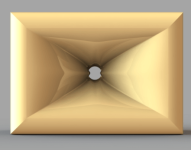As I have spent some time with it, I clearly recognize my work when I see it.

In the above shape, presented on your website, there are so many distinctive features of my original Tritonia formula apparent (some being a mere by-product, having no acoustic rationale), that it's extremely unlikely that it could be designed completely independently. You obviously based a lot of it on my work (which is fine) but it's simply not very polite to present it as if it was all your work.
BTW, Tritonia formula was released under CC BY-NC-SA 4.0.
In the above shape, presented on your website, there are so many distinctive features of my original Tritonia formula apparent (some being a mere by-product, having no acoustic rationale), that it's extremely unlikely that it could be designed completely independently. You obviously based a lot of it on my work (which is fine) but it's simply not very polite to present it as if it was all your work.
BTW, Tritonia formula was released under CC BY-NC-SA 4.0.
Attachments
Last edited:
Lol, it's just an intermediate result, not the final one, and I haven't know about "Tritonia", I discover it today, this form doesn't work but I let this 3D render for avoid copy, well it's works well apparently... it's not the model printed for a reason...
I have hundreds of intermediate version, this one looks like JBL M2 style.
With all my respect (that you became to loose) and despite your huge skill in math, You just showing that you don't understand this kind of horn and how a wave front radiate in a horn, so for response to sheeple, I will not help peoples to copy me, my price is very low according to the R&D time.
Somebody that know this kind of horn would have noticed that the PLA shot is not the same than the 3D render...
I have hundreds of intermediate version, this one looks like JBL M2 style.
With all my respect (that you became to loose) and despite your huge skill in math, You just showing that you don't understand this kind of horn and how a wave front radiate in a horn, so for response to sheeple, I will not help peoples to copy me, my price is very low according to the R&D time.
Somebody that know this kind of horn would have noticed that the PLA shot is not the same than the 3D render...
Can you show us some of your work on "X-Shape" from the pre-Ath4 years?1 . I work on OS Geedees Formula with Elliptic transition and X-Shape before Ath4 even exist (in public, I don't know when he start on it), so ATH4 have nothing to do with my work and like I said in french their is a part of fantasy/miss understanding about M2 like horn, it still the case.
I checked NiсoB's facebook profile and found he changed his profile picture with its the X-Shape horn in 2020.01.12. I did not find any mention of a horn of a similar shape in this thread until NicoB first time demonstrated X-Shape horn in his Facebook profile. Therefore, it seems that the X-Shape horn is a proprietary NicoB design and it is not related to ATH.
We are not personally familiar with NicoB and I have no personal interests.

We are not personally familiar with NicoB and I have no personal interests.
If that's so and your interpretation is correct (*), then please accept my appologies. I'm just fed up with people using my work without giving a reference, and this was really extremely similar to my results. I only don't understand in what sense it's supposed to be so better, but OK.
(*) The photo itself is from June 2023.
(*) The photo itself is from June 2023.
Last edited:
Wow, I can imagine how much time this takes to do by hand and I think I understand the reason behind it. I think it is really clever arrangement and I will definitely try to make something similar when I print my next large horn/waveguide.5 . The back in not generated I spend time on it for some reason too.
No, it's not - that was a "profile picture", not the photo of the "X-Shape" that was added much later. I stand by my claim and my disappointment.If that's so and your interpretation is correct (*), ...
Last edited:
Yes, it seems that you are right. 2020.01.12 was uploaded profile photo photo, while the cover photo (X-Shape) was uploaded couple years later. Facebook's Timeline is a bit confusing. Apparently your claims seem quite valid.
Okay, as Nico does not like to share his knowledge, wherever it comes from, I consulted his site to find an answer. However, it appears that his solution for 'midrange narrowing', what I had called 'waist-banding', is the same as an answer that I had received from @limacon when I commended him for his great simulation results. I cannot find the precise post, but he basically advised me that in order to reduce midrange narrowing on a baffled device, numerous simulation iterations and versions of baffle-box-waveguide-systems were required. The very same thing that I had dropped out, after I could not find the time anymore to do so. This is exactly the approach that is reported on Nico's website. So nothing special from this site:
In any case, I browsed through the table of content of Bjørn Kolbrek’s 'High Quality Horn Systems', that is on his website, and found the following entry:
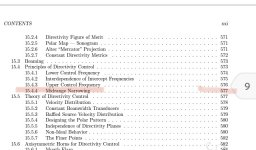
If by chance, anyone has got a copy of the full book and could send me a view of that page in the direct messages, I was very grateful. Maybe, I can find more precise directions on how to tackle this issue there, even formalized conditions and limitations? I can simply not spend so much time on simulation runs, when I am only guessing what I would need to optimize, and maybe I am even hitting against the brick walls that is physics without even knowing so.
Would be very helpful!
What is mid-range beaming or narrowing?
Here we can see a not fully optimised end ogf profile resulting a narrowed mid-range in 1khz region :

It’s an JBL M2, even if the profile is optimized, it doesn’t have a proper complete return on the baffle sides, generating this problem:
A mid-range narrowing, even id its relatively acceptable here, and mid-range beaming as some accident we can see in mid-range region.
That will imbalance the listening experience.
How to deal with it ?
Integration of the horn is as important as the Horn himself, the baffle is in fact a flat 180° horn. So in free air we have to continue the profil smoothly for avoid mouth diffraction and baffle diffraction.
Theses diffraction will cause accidents and a large mid-range narrowing on the global energy radiation behavior that will seriously impact the listening.
Whatever the horn, wageguide, integrated on baffle or not, the contour must be fluid even on reverse side and in all directions.
Here is a very good elliptic wave-guide with a slightly rounded traditional baffle where mid-range beaming and mid-range narrowing are still visible :
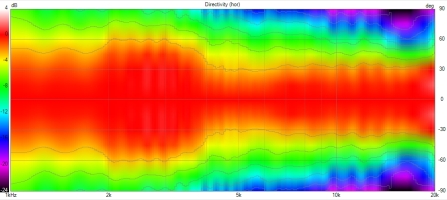
Then the same wave guide (but 0.5" tinier) integrated with a fluid profile :
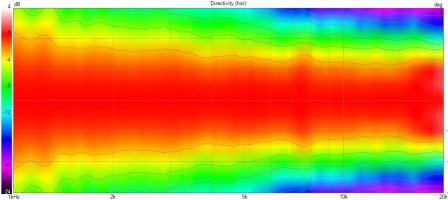
It’s why a fluid profile everywhere matter : A round or elliptic horn into a square baffle even with a round-over will brings accidents and problems.
For solve this we pass from round to rectangular smoothly with the garanti to keep the good radiation behavior of the horn, with this way the horn and the baffle become the same element.
In any case, I browsed through the table of content of Bjørn Kolbrek’s 'High Quality Horn Systems', that is on his website, and found the following entry:

If by chance, anyone has got a copy of the full book and could send me a view of that page in the direct messages, I was very grateful. Maybe, I can find more precise directions on how to tackle this issue there, even formalized conditions and limitations? I can simply not spend so much time on simulation runs, when I am only guessing what I would need to optimize, and maybe I am even hitting against the brick walls that is physics without even knowing so.
Would be very helpful!
Last edited:
The first one was close to a simplify TH4367 we can said but even before it was basics deformation
It's hard to find the first one but a render some time after (of course it don't work at all) :
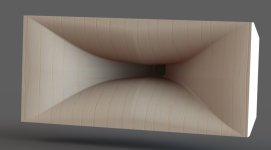
I show my work only when I'm 100% sure that it works and it's the best, the development is underwater (pro development again...), it's a horn that target DIY user and Pro Acoustic people, only a what's app group of 4/5 technical french peoples was aware of what is developed and see the 1st render (again for avoid copy).
As some pro have criticism about JBL way to do this kind of horn I haven't the room for error, from the point of view of Pro Acoustician, so I release it only when it was perfect after years of research of this kind of horn.
You don't realize that professional environment is not DIY one.
It's the same for my bi-radial, I develop him since decade almost but it's only now that I show him because he is perfect just now.
The FaceBook page is recent, I'm not a big fan of social media, it have be done years after R&D, again, you look it with DIY user eyes, it's a professional page, Everything posted on https://www.facebook.com/audiohorn is posted when it's ultra verified with real measurement in box.
How ridiculous it is to look the FB page for a proof of something ? Do you things Kolbrek have a FB page where he put in real time what he develop just for prov that it's him that create it ? Do you thinks he learn he know the moment he write his book ?
Of course not, it's decade of research, ask him, Kolberk studs bi-radial decade ago for example, if I'm not wrong he almost start with this.
Do you want that the french peoples of the group testimony here as a police man ?
Just one things more, don't forget that it's JBL that make this kind of horn firstly, nobody else... not ATH...
And again, a cloud of point or STL don't fit in my FEA, I cannot simulate it as my FEA is a little bit special, as the tools that use Kolberk in FEA, he develop his own solution for himself.
I don't care what look like a horn, I want a perfect and constant expansion in every direction and give loading abilities, I have find how to do it, better than JBL or ath design that I just discover. I consume 100/200Kw/month in electricity since years and I regularly burn RAM, who in DIY is ready to assume the cost/time during years ? That is no more DIY, it's pro FEA.
It's hard to find the first one but a render some time after (of course it don't work at all) :

I show my work only when I'm 100% sure that it works and it's the best, the development is underwater (pro development again...), it's a horn that target DIY user and Pro Acoustic people, only a what's app group of 4/5 technical french peoples was aware of what is developed and see the 1st render (again for avoid copy).
As some pro have criticism about JBL way to do this kind of horn I haven't the room for error, from the point of view of Pro Acoustician, so I release it only when it was perfect after years of research of this kind of horn.
You don't realize that professional environment is not DIY one.
It's the same for my bi-radial, I develop him since decade almost but it's only now that I show him because he is perfect just now.
The FaceBook page is recent, I'm not a big fan of social media, it have be done years after R&D, again, you look it with DIY user eyes, it's a professional page, Everything posted on https://www.facebook.com/audiohorn is posted when it's ultra verified with real measurement in box.
How ridiculous it is to look the FB page for a proof of something ? Do you things Kolbrek have a FB page where he put in real time what he develop just for prov that it's him that create it ? Do you thinks he learn he know the moment he write his book ?
Of course not, it's decade of research, ask him, Kolberk studs bi-radial decade ago for example, if I'm not wrong he almost start with this.
Do you want that the french peoples of the group testimony here as a police man ?
Just one things more, don't forget that it's JBL that make this kind of horn firstly, nobody else... not ATH...
And again, a cloud of point or STL don't fit in my FEA, I cannot simulate it as my FEA is a little bit special, as the tools that use Kolberk in FEA, he develop his own solution for himself.
I don't care what look like a horn, I want a perfect and constant expansion in every direction and give loading abilities, I have find how to do it, better than JBL or ath design that I just discover. I consume 100/200Kw/month in electricity since years and I regularly burn RAM, who in DIY is ready to assume the cost/time during years ? That is no more DIY, it's pro FEA.
yes @sheeple , but all of this is just acoustics basics... nothing extraordinary and nothing new, JMLC bring the first brick about it in 1978 or something like that lol.
Nothing new even at the moment Kolberk write it, the good point of his book that it make it important, he it put forward for everybody, and he is completely right.
Nothing new even at the moment Kolberk write it, the good point of his book that it make it important, he it put forward for everybody, and he is completely right.
I figure. As I am not an audio professional but visual artist that came to use the great tool that Marcel provided us with, I am lacking the acoustics basics. Which is why I would be happy to learn about formalizations of the issue, to find out what is attainable within a certain form factor and what's beyond reach. Thanks.yes @sheeple , but all of this is just acoustics basics... nothing extraordinary and nothing new
With all respect to everyone here, isn't this going a bit too far ?
What do mabat with ath, NicoB on audiohorn web site , Kimmo VituixCad for exemple are jewels for all of us diyer's !
May I humbly suggest that we go back on subject
And sorry if it sounds moralazing which is not intended
We have to not forget what is going really bad around us (war, disaster to name a few...)
What do mabat with ath, NicoB on audiohorn web site , Kimmo VituixCad for exemple are jewels for all of us diyer's !
May I humbly suggest that we go back on subject
And sorry if it sounds moralazing which is not intended
We have to not forget what is going really bad around us (war, disaster to name a few...)
I think it is understandable that one expects credit, at least for the intellectual work on a subject, if someone uses a concept in commercial products. Everytime I see a commercial product on the internet that is clearly Ath-based, I wonder: have they asked and Marcel had allowed them to? Do they maybe even pay license fees? After all, the donations weren't enough, obviously, to pursue Marcel to sustain active development of Ath.
Hi,I figure. As I am not an audio professional but visual artist that came to use the great tool that Marcel provided us with, I am lacking the acoustics basics. Which is why I would be happy to learn about formalizations of the issue, to find out what is attainable within a certain form factor and what's beyond reach. Thanks.
diffraction at the mouth. You need proper round over to avoid the waist banding. When ever there is abrupt change in acoustic impedance, in other words a physical structure has an abrupt change, an edge, there will be diffraction related back wave that emits at the edge and is responsible for the effect. There might be more to it depending on circumstances, but this is enough to get you on to the subject and experimenting.
Basically, you must ensure the waveguide profile is smooth enough not to cause diffraction before you get to "baffle plane", eg. 90deg rotation with the profile, but you must continue the profile even past that in order to get either diffraction related backwave more or less gone, or have the diffraction backwave at lower frequency (mostly) where the "waist banding" is not at the device main bandwidth anymore but at the knee where it is about to lose pattern control, and now the "waist banding" doesn't look ugly in the graph anymore but extends the pattern control to lower frequency. You might be able to make a device so that the waist banding is "on the bandwidth" and the main pattern gets narrower higher than that. But if you want wide pattern device, you must reduce diffraction related backwave propagating 90deg I think.
If you want boxy box, I'm quite sure you are going to get some waist banding, edge diffraction, and that's fine. A lot of people have boxy boxes without much complaint, with or without waveguide.
Hopefully this gives you hint how to manipulate your script. You can tweak to this stage in few evenings, or use some profile that is shared on the thread for jump start.
Last edited:
Do you think I will believe, Nico, that no (R-)OSSE formulas were used in your recent work?
Do you understand that those formulas are my work?
If you base your work on those formulas, you should mention that when you present the work. Or at least a moderately polite person would do that.
https://www.homecinema-fr.com/forum/post180138429.html#p180138429Suis arrivé à un truc pas mal (je précise que je n'utilise pas Ath4 ou 5, je lui pique juste la formule
Do you understand that those formulas are my work?
If you base your work on those formulas, you should mention that when you present the work. Or at least a moderately polite person would do that.
Last edited:
Thanks, @tmuikku. So this simulated box here: https://www.diyaudio.com/community/...708-ish-dimensioned-2-way.377634/post-7469826, I had also simulated with 'proper' round edges. I think the set radius/depth in both cases was 5 or 7 cm. Results did actually not differ too much for the problem that I was trying to tackle, midrange narrowing. So for sake of later easier construction, I chose to go with beveled baffle edges instead. Could not get rid of midrange narrowing though! No matter what I tried. I immediately correct myself: narrowing was obviously easily pushed further down the frequency range with an increased baffle width, but this required too wide baffles for my taste. I had received better results with narrower patterns before than with the 120 to 140 degrees, which I was aiming for more recently. So this could be another factor, pattern width vs. baffle width. But I cannot know for sure, as I di not have the formal education in this field and would not know how to gauge the theoretical limits.
Do you think I will believe, Nico, that no (R-)OSSE formulas were used in your recent work?
https://www.homecinema-fr.com/forum/post180138429.html#p180138429
https://www.homecinema-fr.com/forum/post180138850.html#p180138850
Do you understand that those formulas are my work?
If you base your work on those formulas, you should mention that when you present the work. Or at least a moderately polite person would do that.
You shoot yourself in the foot alone, this topic is a promotion of all horn generator including yours for helping people to use it (first time I see somebody shooting people helping him), someone ask me what happen if we just revert the angle for create a pinch.
Spoiler alert : It don't works.
As you know perfectly because you apparently create your things specially because reverting angle in OSSE doesn't work at all.
What is the purpose to take a message out of context in french for something that you know that it not works ?
Before it was "he use Ath4" now it's formula, if I have somebody to thanks it's Dr. Earl Geddes for OS formula and I have cited OS many time on the website.
X-Shape is a response of what OS cannot do, accept it, it's not a question of math but FEA.
If I follow you, 10 years ago, JBL have travel in the future for make the M2 with your tool, do you really things your tool is the only one way to do this kind of horn ?
Last edited:
No, I never said that. It's only you who gets more and more pathetic.Before it was "he use Ath4 ..."
your said "It's hard to believe it's not based directly on my work" and then show an ATH conf, what I was supposed to understand ?
So ok if you talk about formula no sorry, it's driven by FEA, so the concept of formula is not the same (or even not exists).
As I said and has you already know, reverted OSSE doesn't works.
Your way too thinks is full math -> mesh-> then BEM, I'm in almost opposite way to do (as JBL, as PURIFI...).
You do a really great jobs with your way to do but it's not how FEA pro works, nobody is better than another one, it's just different, we have a more "wave front approach"
So ok if you talk about formula no sorry, it's driven by FEA, so the concept of formula is not the same (or even not exists).
As I said and has you already know, reverted OSSE doesn't works.
Your way too thinks is full math -> mesh-> then BEM, I'm in almost opposite way to do (as JBL, as PURIFI...).
You do a really great jobs with your way to do but it's not how FEA pro works, nobody is better than another one, it's just different, we have a more "wave front approach"
- Home
- Loudspeakers
- Multi-Way
- Acoustic Horn Design – The Easy Way (Ath4)
